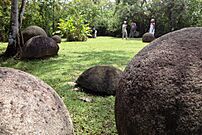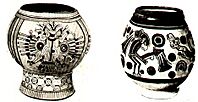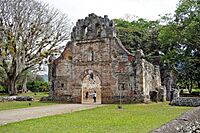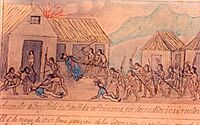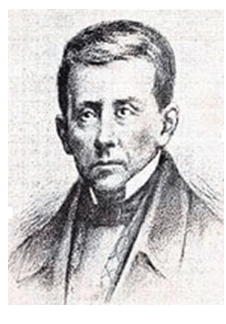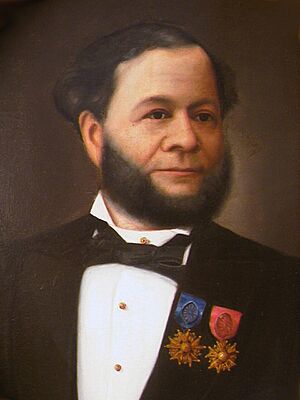History of Costa Rica facts for kids
The first people in Costa Rica were hunters and gatherers. When Spanish explorers arrived, Costa Rica was a mix of two different cultural areas. This was because of its location between the big Mesoamerican and Andean cultures.
Christopher Columbus first landed in Costa Rica in 1503. Spain then took control of the land in 1524. For the next 300 years, Costa Rica was a Spanish colony. This meant that Spanish culture had a big impact on the country. During this time, Costa Rica remained a quiet and not very wealthy place.
After Mexico became independent in 1821, Costa Rica joined the Mexican Empire. Later, in 1823, it became part of the Federal Republic of Central America. Costa Rica became fully independent in 1828. Its economy faced challenges because it was hard to trade with European countries. In 1856, Costa Rica fought off American settlers who tried to take over the government.
After 1869, Costa Rica started to build a democratic government.
In 1948, after a short civil war, Costa Rica created a new rulebook for the country, called a constitution. This new constitution gave everyone the right to vote and got rid of the army. Today, Costa Rica is a democracy. Its economy relies on technology and tourism that focuses on nature. While poverty has gone down, the country still faces economic issues like people not having enough work and national debt.
Contents
Early Hunter-Gatherers
The oldest signs of people living in Costa Rica are from groups of hunters and gatherers. They arrived about 10,000 to 19,000 years ago. Archaeologists have found ancient stone tools in the Turrialba Valley. These tools include spearheads, which show that two different cultures might have lived there.
The people of this time moved around a lot. They lived in small family groups of about 20 to 30 members. They hunted very large animals, like giant armadillos, sloths, and mastodons. These huge animals died out about 8,000 years ago. So, the early settlers had to learn to hunt smaller animals and change their ways of living.
Ancient Cultures of Costa Rica
Before Christopher Columbus arrived, the native people in Costa Rica lived in two main cultural areas. This was because Costa Rica is located between the big Mesoamerican cultures to the north and the Andean cultures to the south.
The northwest part of the country, called the Nicoya Peninsula, was the southernmost area influenced by Mesoamerican culture. The Nicoya culture was the largest chiefdom on Costa Rica's Pacific coast. The central and southern parts of the country were influenced by cultures from what is now Colombia. The Diquis culture was strong from 700 CE to 1530 CE. They were known for their amazing metal and stone artwork.
The native people had a small impact on modern Costa Rican culture. Soon after Europeans arrived, many native people died. They caught diseases like measles and smallpox from the Europeans. The native people had never been exposed to these illnesses before, so they had no protection against them.
Spanish Rule in Costa Rica
The time of Spanish rule began when Christopher Columbus landed on Costa Rica's eastern coast on September 18, 1502. Many Spanish trips followed. The first Spanish settlement in Costa Rica, Villa Bruselas, was founded in 1524.
For most of this time, Costa Rica was the southernmost province of Guatemala. It was officially part of the Viceroyalty of New Spain, which is now Mexico. But in reality, Costa Rica mostly ran itself. It was far from the capital in Guatemala. Spanish law also stopped it from trading with its neighbors in Panama. Plus, Costa Rica did not have much gold or silver. Because of this, few people wanted to live there. It was a poor, isolated, and thinly populated area within the Spanish Empire. In 1719, a Spanish governor called Costa Rica "the poorest and most miserable Spanish colony in all America."
Many historians say that there were not enough native people for forced labor. This meant that most Costa Rican settlers had to work their own land. This stopped large farms, called haciendas, from being built. For these reasons, the Spanish Crown mostly ignored Costa Rica. This allowed the people to develop their own way of life. The small landowners were not rich. There was no large native workforce. Most people were from similar backgrounds and spoke the same language. Costa Rica was also far from the main Spanish centers in Mexico and the Andes. All these things helped create a society of independent farmers. Even the governor had to grow his own food because he was poor. This led to a farming economy in the 1700s, not one based on forced labor.
When the Spanish arrived, about twenty different native groups lived in the area. Hundreds of thousands of people spoke many different languages. The Spanish takeover of Costa Rica lasted more than 50 years, starting in 1510. First, the Spanish enslaved the native groups of Nicoya on the Pacific North coast. Then, they tried to build a Spanish settlement on the Caribbean side, but it was hard. During this time, the Spanish greatly reduced the native population. Many died from diseases, war, revenge, forced moves, and harsh treatment. The native population was about 120,000 in 1569. By 1611, it had fallen to only 10,000.
Becoming Independent from Spain
In the early 1800s, Napoleon took over Spain. This led to many revolts across Spanish America. In New Spain, the fight for independence happened mostly in what is now central Mexico from 1810 to 1821. Once the Spanish ruler was defeated in Mexico City, news of independence spread to all parts of New Spain. This included the areas that used to be part of Guatemala. Costa Rica joined other Central American areas in declaring independence from Spain in 1821.
On October 13, 1821, the independence papers reached Cartago, Costa Rica. An urgent meeting was called by Governor Juan Manuel de Cañas. There were many ideas about what to do after gaining independence. Some wanted to join Mexico, others Guatemala, or even Colombia. A temporary government was formed. They famously said they would wait "while the clouds clear up."
Independence from Spain was officially recognized on October 29, 1821, by the Spanish leaders. It was then confirmed in other cities: San José on November 1, 1821; Cartago on November 3, 1821; Heredia on November 11, 1821; and Alajuela on November 25, 1821.
After declaring independence, the Mexican parliament wanted to create a system where the King of Spain would also be the Emperor of New Spain. Both countries would have their own laws. But the King of Spain did not agree to this. He said Spain would not let any other European prince rule New Spain.
So, the president of the Mexican government, Agustín de Iturbide, was made Emperor of New Spain, which was renamed Mexico. The Mexican Empire lasted from 1821 to 1823. It included all the areas of New Spain, including those from the former Captaincy General of Guatemala.
On April 5, 1823, the Battle of Ochomogo was fought. Forces from Cartago, led by Joaquín de Oreamuno, wanted to join the Mexican Empire. Republican forces, led by Gregorio José Ramírez, wanted to stay independent. The Republicans won, and the capital moved from Cartago to San José.
Central American Federation
In 1823, a revolution in Mexico removed Emperor Agustín de Iturbide from power. A new Mexican congress allowed the Central American areas to decide their own future. That year, the United Provinces of Central America was formed. It included five Central American areas, led by General Manuel José Arce. These areas became known as States. This federation was not very strong and quickly broke apart due to rivalries between the different States.
After gaining full independence in 1838, Costa Rica had no regular ways to sell its coffee to Europe. It was hard to transport goods because the coffee farms were mostly in the Central Valley. They could only reach the port of Puntarenas on the Pacific coast. Before the Panama Canal opened, ships from Europe had to sail all the way around South America to reach the Pacific. In 1843, a merchant named William Le Lacheur helped Costa Rica set up a trade route to Europe.
In 1856, an American adventurer named William Walker started invading Central America. He landed in Nicaragua, declared himself president, and brought back slavery. He planned to expand into Costa Rica. When he entered Costa Rican land, the country declared war against him. Led by President Juan Rafael Mora Porras, the Costa Rican army defeated Walker's forces and pushed them out of the country. Costa Rican soldiers followed Walker into Nicaragua. In a final battle, William Walker and his forces were finally defeated. In this battle, Juan Santamaría, a young drummer boy, bravely gave his life by setting fire to Walker's stronghold. He is now remembered as a national hero.
The Republic of Costa Rica
A time of peaceful democracy in Costa Rica began in 1869 with elections. Costa Rica has mostly avoided the violence that has affected other Central American countries. Since the late 1800s, there have only been two short periods of violence. From 1917 to 1919, Federico Tinoco Granados ruled as a dictator.
In 1948, José Figueres Ferrer led an armed uprising after a disputed presidential election. This 44-day civil war was the bloodiest event in Costa Rica's 20th century, with over 2,000 people dying. The winning group created a new constitution. This constitution guaranteed free elections where everyone could vote and, importantly, it got rid of the military. Figueres became a national hero. He won the first election under the new constitution in 1953. Since then, Costa Rica has been one of the few democracies without a standing army. The country has held 17 peaceful presidential elections in a row, with the latest in 2022. In May 2022, Rodrigo Chaves became Costa Rica's new president for a four-year term.
Costa Rica's economy changed a lot in 1978. It went from being a successful economy to facing a serious crisis. Costa Rica used to rely on selling bananas and coffee. In 1978, coffee prices dropped, and the country earned less money. In 1979, the price of oil, which Costa Rica imported a lot, went up very quickly. This pushed the country into a crisis. To help the economy, President Rodrigo Carazo kept borrowing money from other countries. This led to even more national debt.
Once mainly a farming country, Costa Rica has now shifted to technology and services. Tourism focused on nature is also very important. Costa Rica's main source of money from exports now comes from technology. Companies like Microsoft, Motorola, and Intel have set up businesses there. Local companies also create and sell computer software and other related products. Tourism is growing fast, and many believe it will soon be the biggest part of the country's economy. Traditional farming, especially coffee and bananas, is still an important part of Costa Rica's exports.
See also
 In Spanish: Historia de Costa Rica para niños
In Spanish: Historia de Costa Rica para niños
- List of presidents of Costa Rica
- Politics of Costa Rica
- History of Central America
- Spanish colonization of the Americas



